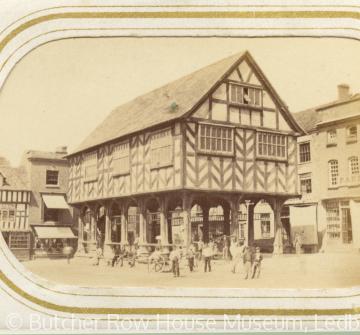Markets and Fairs
 Ledbury Market House in the 1860s
Ledbury Market House in the 1860sFor centuries, markets and fairs were places where face-to-face trading took place, at set times and places. They were subject to regulation, often laid out in a market charter, granted by the king or other lord. Some charter markets had special courts to regulate them, often known as pie-powder courts, the term coming from medieval French, pié-poudré - reflecting the dusty feet of those who came to market. Many markets operated as prescriptive markets, having existed 'time out of mind', and were subject to the regulation of the local manorial court.
The pattern of weekly markets at centres of population (even small villages) was complemented by periodic fairs, sometimes held in the countryside. These more remote settings may reflect very ancient gathering places, where people came together to pay tribute or tax. By c.1300 there were about 600 towns in England, mostly small market towns, and about 1,000 more markets in rural areas. More information on these early markets and fairs can be found at the Gazetteer of Markets and Fairs in England and Wales to 1516.
Markets in towns and villages were often held in special areas, which can still be traced on the ground today. Rectangular or lozenge-shaped 'broad street' spaces were probably the most common form, no more than the widening of a main route through a settlement. Especially in the 12th century when many new boroughs were planned, square or rectangular areas were set aside for the market. Some triangular market places were set out at the gates of monasteries, others arose at road junctions.
During the late 16th and early 17th centuries many towns built market houses. These offered shelter for traders and customers and storage for goods and also reflected civic pride. Many of them had upper rooms which were used for meetings, becoming, in effect, a town hall. During the 18th & 19th centuries larger towns, especially, built ever grander market buildings, tidying the often messy business of market trading off the streets.
The number of markets has declined remarkably over the 20th century and those that survive often have very few stall holders. The number of fairs has not only declined, but their nature has altered. Very little trading now goes on, except at some horse fairs, and the entertainment element, which had always run beside the trading fairs, is now their main function.










